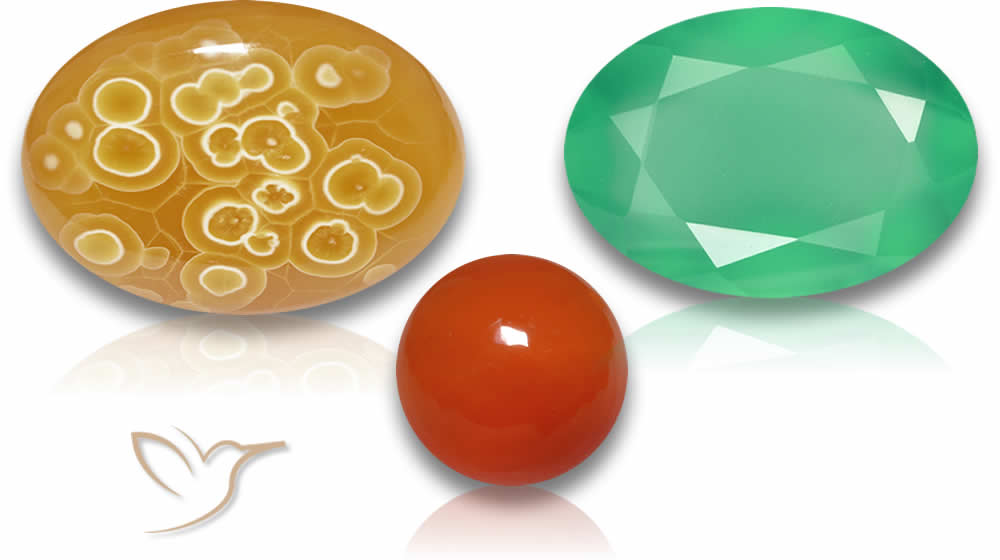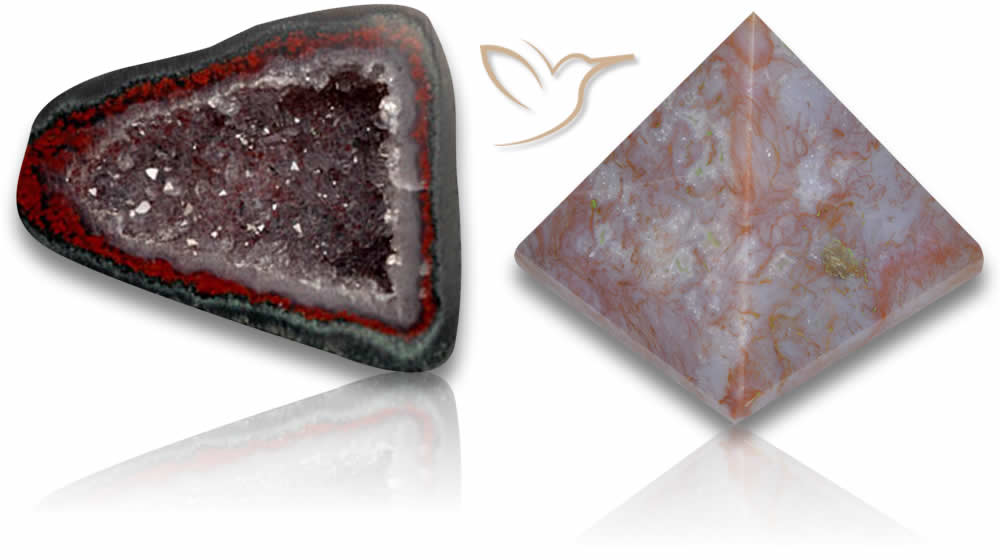All About Agate - Your Gemstone Guide

Welcome to our comprehensive guide on agate gemstone, where we explore the captivating world of agate and its many qualities. Agate is a true natural wonder and has been revered for centuries for its unique gemological properties, stunning colors, impressive clarity, and radiant luster. In this guide, we will delve into the fascinating history of agate, its mesmerizing colors, and the diverse shapes it takes.
We'll explore the various factors that contribute to agate's beauty, including its transparency, translucency, and the striking play of light within its crystal structure. Furthermore, we'll provide insights into the hardness of agate, mining locations, treatments commonly applied to enhance its appearance, and how to care for and clean these precious stones.
Whether you're a jewelry enthusiast or simply drawn to the beauty of natural gemstones, this guide is the ultimate resource for learning about agate. Read on to discover the captivating world of agate.
Please feel free to explore our stock of agate for sale.
Key Takeaways
- Agate is a gemstone with a rich history and unique gemological properties.
- Agate comes in a wide range of colors and shapes, making each piece of jewelry unique.
- Transparency, translucency, and play of light are factors that contribute to agate's beauty and radiance.
- Agate is a durable gemstone, and its hardness affects its usage in jewelry.
- Agate is mined in various locations around the world, each producing unique geological formations.
A Brief History of Agate
Agate has a fascinating history dating back to ancient times. This mesmerizing gemstone was named by the great philosopher Theophrastus over 2,000 years ago. The name stems from the Greek word "agathos," meaning good, as agate was beloved for its perceived healing properties. The ancient Egyptians were among the first civilizations to use agate in jewelry, and it was also incorporated into amulets and talismans.
Agate comes in a wide variety of types, including banded agate, moss agate, dendritic agate and fire agate, each with unique characteristics and properties. Banded agate is known for its distinctive bands of color and is often used in cameos and intaglios. Moss agate is a variety that features inclusions that resemble moss and is believed to promote mental clarity and creative inspiration. Dendritic agate is distinguished by its moss-like patterns. Fire agate is treasured for its fiery hues and is used extensively in Native American jewelry.
| Agate Types | Description |
|---|---|
| Banded agate | A variety of agate with distinctive bands of color. |
| Moss agate | A type of agate with inclusions resembling moss or ferns. |
| Dendritic agate | A type of agate with moss-like inclusions. |
| Fire agate | Agate treasured for its fiery hues. |
In addition to its popularity in jewelry, agate holds significant cultural significance. Ancient Persians believed that agate provided protection from danger, while American Indians revered it as a powerful healing stone. Today, agate remains a popular gemstone and is often used in statement jewelry pieces. Its remarkable qualities and rich history make it a true gemstone treasure.
The Mesmerizing Colors of Agate
Agate is a gemstone known for its captivating colors. Each piece is unique, with intricate patterns and combinations of shades ranging from reds, pinks, blues, greens, and browns, to name just a few. The color variation and banding patterns depend on the type of agate and the minerals present during formation.
Many types of agate get their names from their color. For instance, Botswana agate is known for its beautiful layering of grey, pink, and brown bands that resemble the landscape of Botswana. Blue lace agate, on the other hand, displays beautiful blue coloration that often appears veiled or banded. Some agate types, such as moss agate, display intricate layering that resembles moss or foliage, which gives it its green hue.
In addition, agate's translucency can add depth and brightness to its colors, making it a gemstone that is often complimented by light sources. This play of light is particularly evident in fire agate, which, in addition to its translucent qualities, displays a fiery play of color that ranges from orange to iridescent green.
The colors of agate are one of the reasons that make it a popular gemstone in jewelry design. Whether it's a statement piece or an everyday piece, agate's natural beauty can add a pop of color and distinctiveness to any jewelry collection.
Unveiling the Clarity and Luster of Agate
Agate's beauty is defined by its clarity and luster. Its transparent and translucent nature allows light to penetrate and reflect throughout its crystal structure, creating a mesmerizing play of light. The radiant luster of agate makes it an ideal gemstone for jewelry, adding a captivating sparkle to any piece.
Agate's clarity is impacted by various factors, including the presence of inclusions, blemishes, and fractures. However, these imperfections can add character and uniqueness to the stone, making each agate piece one-of-a-kind.
When it comes to luster, agate has a unique matte sheen which sets it apart from other gemstones. This distinct finish is achieved through the use of polishing techniques, which further highlights the intricate patterns and colors found in agate.
Exploring the Diverse Shapes of Agate
Agate is available in a variety of captivating shapes, ranging from the classic round cabochons to elaborate geode formations. Each agate shape is unique and is formed due to natural geological processes that occur over a period of millions of years.
Some of the popular agate shapes are:
| Shape | Description |
|---|---|
| Cabochon | A smooth and rounded dome-shaped agate with a flat base, perfect for rings, brooches, and pendants. |
| Bead | Spherical agate beads commonly found in necklaces, bracelets and earrings, available in a range of sizes from tiny to large. |
| Geode | Agates with hollow cavities lined with crystals and intricate patterns formed in the center as they grow. Geodes add an element of natural beauty to any space, and can be displayed on a tabletop or used as bookends, paperweights, and more. |
| Freeform | Irregularly shaped agates for artistic and unique jewelry designs. |
Ultimately, the shape of agate you select for your jewelry pieces comes down to your personal preference and the intended use of the stone. With its wide variance in shape and size, agate offers endless design possibilities for your creations.
Understanding Agate Treatments
Agate is generally untreated as it is not a particularly expensive colored gemstone so expensive heat treatments are not very common but dyeing agate does happen in order to enhance some of the colors and the banding.
Agate's Hardness and Mining Locations
Agate is a relatively hard stone, rated at 6.5-7 on the Mohs scale of mineral hardness. This makes it a durable choice for jewelry, but precautions should still be taken to prevent scratches or damage.
Agate is found worldwide, but some locations are more well-known for producing high-quality stones. Brazil is the largest producer of agate, with the Rio Grande do Sul region known for its colorful variations. Germany is also well-known for its agate deposits, particularly the Idar-Oberstein region. In the United States, deposits can be found in Oregon, Washington, and Montana. Other countries with agate deposits include Russia, India, and Madagascar.
| Country | Mining Locations |
|---|---|
| Brazil | Rio Grande do Sul |
| Germany | Idar-Oberstein |
| United States | Oregon, Washington, Montana |
| Russia | Ural Mountains |
| India | Gujarat, Maharashtra |
| Madagascar | Fort Dauphin |
The geological formations in each location contribute to unique variations in the agate color, pattern, and shape. Some agate mines are located in volcanic rocks, while others are found in sedimentary deposits. This variety makes each agate stone truly one-of-a-kind.
Understanding the hardness of agate and its mining locations can help you appreciate the rarity and beauty of this breathtaking gemstone.
Conclusion
In conclusion, agate is a gemstone that continues to captivate the jewelry world with its stunning qualities. For those in search of unique and captivating jewelry designs, agate is an excellent choice. Its diverse colors and shapes offer endless possibilities for creative expression. What’s more, it’s said to possess various healing properties, including soothing energy, emotional balance, and physical strength.

Agate is also significant as a birthstone and anniversary gem. It’s the birthstone for those born in May and the traditional gift for the 12th wedding anniversary. As for its price, agate is relatively affordable compared to other gemstones, making it a popular choice for jewelry enthusiasts.
When it comes to caring for and cleaning agate, it's essential to avoid harsh chemicals and abrasive cleaning agents. Instead, gently clean it with warm, soapy water and a soft brush. It's also important to protect your agate jewelry from exposure to extreme heat and sunlight, as they can cause fading and discoloration.
Overall, agate is a gemstone that offers endless beauty and versatility. Whether you’re looking to create a stunning piece of jewelry or harness its healing properties, the possibilities are truly endless.
FAQ
What are the gemological properties of agate?
Agate is a variety of chalcedony, known for its beautiful bands and vibrant colors. It has a hardness of 6.5-7 on the Mohs scale and a specific gravity of 2.60-2.65. Agate has a vitreous to greasy luster and can be translucent to opaque.
What are the different types of agate?
Agate comes in various types, including moss agate, agate geode, banded agate, blue lace agate, dendritic agate, and fire agate. Each type showcases unique patterns and color combinations, adding to the allure of the stone.
What colors can agate exhibit?
Agate can display a wide range of colors, including red, green, blue, brown, black, white, and various combinations of these hues. The colors are often stunningly vibrant and can be seen in both solid and banded forms.
How clear and lustrous is agate?
Agate has excellent transparency and can range from transparent to opaque. Its luster is typically vitreous to greasy, adding a beautiful shine to the stone when cut and polished.
In what shapes does agate occur?
Agate is found in a variety of shapes, including cabochons, beads, druzy clusters, geodes, and tumbled stones. These shapes highlight the unique patterns and formations within the stone.
Are there any treatments applied to agate?
Agate is sometimes treated to enhance its appearance. These treatments may include dyeing to add or intensify colors and to improve the stone's shine.
How hard is agate, and where is it mined?
Agate has a hardness of 6.5-7 on the Mohs scale, making it relatively durable for jewelry use. It is mined in locations worldwide, such as Brazil, Uruguay, India, Australia, and the United States.
What should I know about agate jewelry design ideas, healing properties, birthstones, price, care, and cleaning?
Agate offers endless possibilities for jewelry design, with its vibrant colors and unique patterns. It is believed to have various healing properties, such as promoting stability and protection. Agate is associated with certain birthstones and anniversaries. The price of agate varies depending on its quality and size. To care for agate jewelry, it is recommended to avoid harsh chemicals and clean it with mild soap and a soft cloth.

